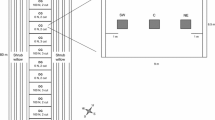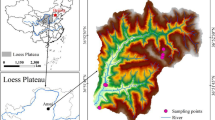Abstract
In this study we determined soil moisture storage, evapotranspiration (ET) and light interception in an agroforestry trial consisting of pine trees grown over (1) control (bare ground), (2) ryegrass/clovers (Lolium perene/Trifolium spp.), (3) lucerne (Medicago sativa), and (4) ryegrass only during the third growing season between 1992 and 1993. The results show that:
-
1.
In the period when rainfall was frequent and exceeded the evaporative demand (Epot), ET and depletion of soil moisture were not affected by the ground cover treatments. During summer when rainfall was less frequent, but with moisture readily available in the soil profile, ET was associated with plant canopy, and was significantly higher for the pasture ground covers than for the control. Therefore, the more rapid growth by lucerne caused higher ET in this ground cover than in the ryegrass/clovers ground cover in which the pasture was slow growing. At the end of the study period, total ET was in the following order: lucerne (757 mm) > ryegrass/clovers (729 mm) > Control (618 mm).
-
2.
ET was dominated by pasture transpiration (Ep) during most of the growing season, but by tree transpiration (Et) in winter when large parts of the pasture canopy was shaded. Ep was always at least 16% higher for lucerne than for ryegrass/clovers species as a result of a greater radiation intercepted by the former.
-
3.
Fraction of incoming radiation intercepted by the tree crowns was in the following order: control > ryegrass > ryegrass/clovers > lucerne. At the end of the one-year period, fraction of intercepted radiation was 140% greater for control than for lucerne ground cover.
-
4.
The control produced the largest tree crowns, which were almost twice the tree crowns in the lucerne ground cover which produced the smallest trees. Accordingly, the trees in the control intercepted more radiation and rainfall, with the former being lost to evaporation, than the trees in the pasture.
-
5.
The fractions of radiation intercepted and ET accounted for by the trees and pastures were associated with the proportion of the plot area they occupied.
Similar content being viewed by others
Abbreviations
- Ep :
-
transpiration through the pasture canopies (mm)
- Epot :
-
potential evapotranspiration using Penman equation (mm)
- EPT :
-
potential evaportranspiration using Priestley-Taylor equation (mm)
- ET:
-
evaportranspiration from the agroforestry plots (mm)
- Et:
-
transpiration through the radiata pine canopies (mm)
- PAR:
-
photosynthetically active radiation (400 to 700 nm)
- Q:
-
fractions of incident radiation intercepted by the pasture canopies (Qp) soil surface (Qs) and tree crowns (Qt)
- S :
-
moistured stored in the soil profile (mm)
References
Bennet OL and Doss DB (1960). Effect of soil moisture levels on root distribution of cool-season forage species. Agron J 52: 204–207
Black TA and Kelliher FM (1989) Processes controlling understory evapotranspiration. Phil Trans R Soc London Ser B 324: 207–231
Clinton PW and Mead DJ (1990) Competition between pine and pastures: an agroforestry study. in: Proc AFDI Biennial Conference, pp 145–154. 5–8 October, Bunbury, Western Australia
Cooper PJM, Keatinge JDH and Hughes G (1983). Crop evaporation — a technique for calculation of its components by field measurements. Field Crops Res 7: 67–84
Denmead OT (1969) Comparative micrometeorology of a wheat field and a forest ofPinus radiata. Agr Meteorol 6: 357–371
Denmead OT and Shaw RH (1962) Availability of soil water to plants as affected by soil moisture content and meteorological conditions. Agron J 45: 385–390
Eastham J and Rose CW (1988) Pasture evapotranspiration under varying tree planting density in an agroforestry experiment. Agric Water Manage 15: 87–105
Gash JHC (1979) An analytical model of rainfall interception in forests. QJR Meteorol Soc 105: 43–55
Grace JC, Jarvis PG and Norman JM (1987). Modelling the interception of solar radiant energy in intensively managed stands. N Z J For Sci 17: 193–209
Hawke MF and Wedderburn ME (1994) Microclimate changes underPinus radiata agroforestry regimes in New Zealand. Agric For Meteorol 71: 133–145
Jamieson PD (1985) Soil moisture extraction patterns from irrigated and dryland arable crops in Canterbury. Proc Agron Soc NZ 15: 1–6
Kear BS, Gibbs HS and Miller RB (compilers) (1967) Soils of the Downs and Plains of Canterbury and North Ontago, New Zealand. Soil Bureau, Wellington, New Zealand
Knowles RL, Hawke MF and Maclaren JP (1992) Agroforestry research at Tikitere. Agroforestry research collaborative Report no. 19. NZ FRI, Rotorua
Mead DJ, Lucas RJ and Mason EG (1993) Studying interactions between pastures andPinus radiata in Canterbury's sub-humid temperate environment — the first two years. NZ Forestry 26–31
Monteith JL, Ong CK and Corlett JE (1991) Microclimate interactions in agroforestry systems. For Ecol Manage 45: 31–44
Monteith JL and Unsworth MH (1990) Principles of Environmental Physics. Edward Arnold, London, 241 pp
Ong CK (1990) Interaction of light water, and nutrients in agroforestry systems. In: Avery ME, Cannell MGR and Ong CK (eds) Biophysical Research for Asian Agroforestry, pp 107–124. Winrock International, USA, and Oxford & IBH Publishing Co. PVT Ltd, New Delhi, Bombay, Calcutta.
Palmer JW and Jackson JE (1977) Seasonal light interception and canopy development in hedgerow and bed system apple orchards. J Appl Ecol 14: 539–549
Priestley CHB and Taylor RJ (1972) On the assessment of surface heat flux and evaporation using large scale parameters. Monthly Weather Rev 108: 81–92
Santantonio D and Santantonio E (1987) Effects of thinning on production and mortality of fine roots inPinus radiata plantation on a fertile site in New Zealand. Can J For Res 17: 919–928
Singh P and Sri Rama YV (1989) Influence of water deficit on transpiration and radiative use efficiency of chickpea (Cicer arietinum). Agric For Meteorol. 48: 317–330
Whitehead D, Kelliher FM, Frampton CM and Godfrey MJS (1994a). Seasonal development of leaf area in a young, widely spacedPinus radiata D. Don stand. Tree Physiol 14: 1019–1038
Whitehead D, Kelliher FM, Lane PM and Pollock DS (1994b) Seasonal partitioning of evaporation between trees and understory in a widely-spacedPinus radiata stand. J Appl Ecol 31: 528–542
Yunusa IAM, Mead DJ, Lucas RJ and Pollock KM (1995) Process studies in aPinus radiata-pasture agroforestry system in a subhumid temperate environment. II. Analysis of dry matter yields in the third year. Agroforestry Systems 32: 185–204 (this issue)
Yunusa IAM, Sedgley RH, Belford RK and Tennant D (1993) Dynamics of water use in a dry mediterranean environment. I. Soil evaporation little affected by the presence of canopy. Agric Water Manage 24: 205–224
Yunusa IAM, Sedgley RH and Siddique KHM (1994) Influence of, mulching on the pattern of growth and water use by spring wheat and soil moisture storage on a fine textured soil. Plant Soil 160: 119–130
Author information
Authors and Affiliations
Rights and permissions
About this article
Cite this article
Yunusa, I.A.M., Mead, D.J., Pollock, K.M. et al. Process studies in aPinus radiata-pasture agroforestry system in a subhumid temperature environment. I. Water use and light interception in the third year. Agroforest Syst 32, 163–183 (1995). https://doi.org/10.1007/BF00711571
Issue Date:
DOI: https://doi.org/10.1007/BF00711571




